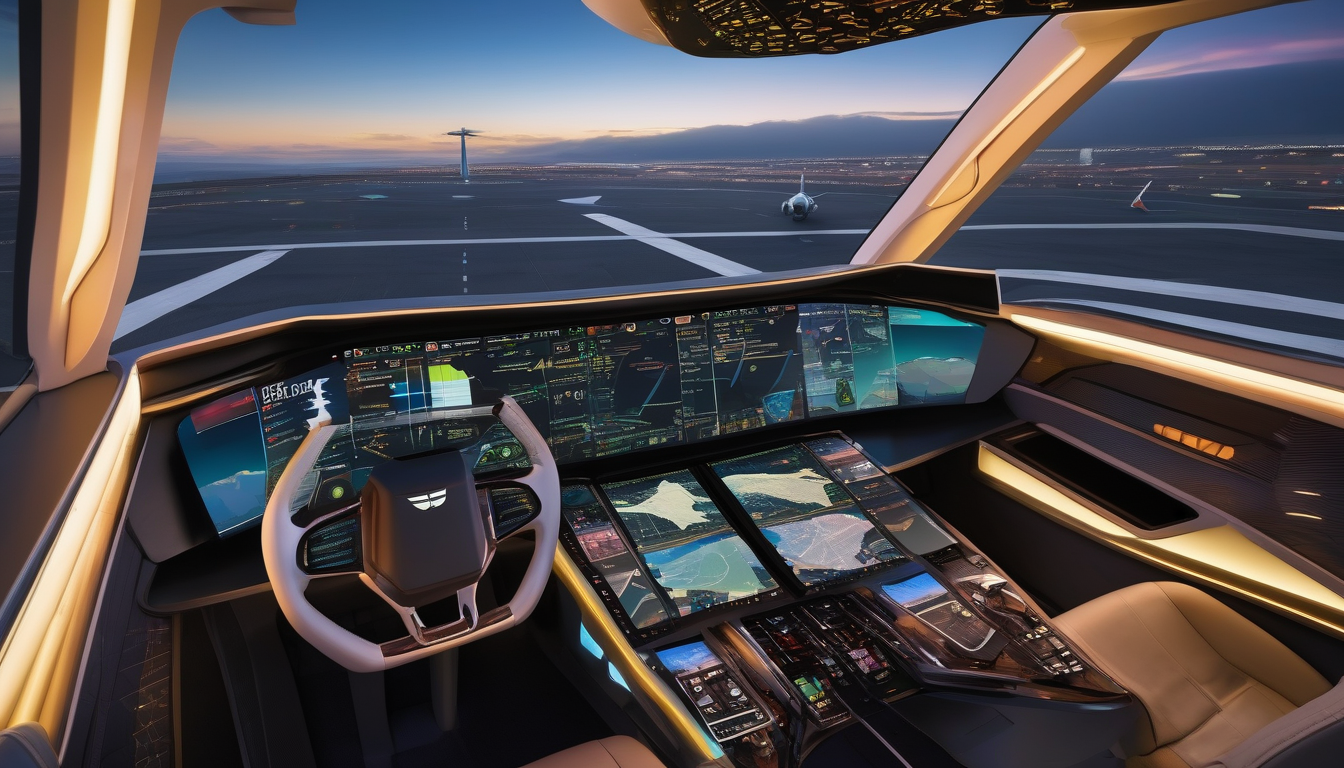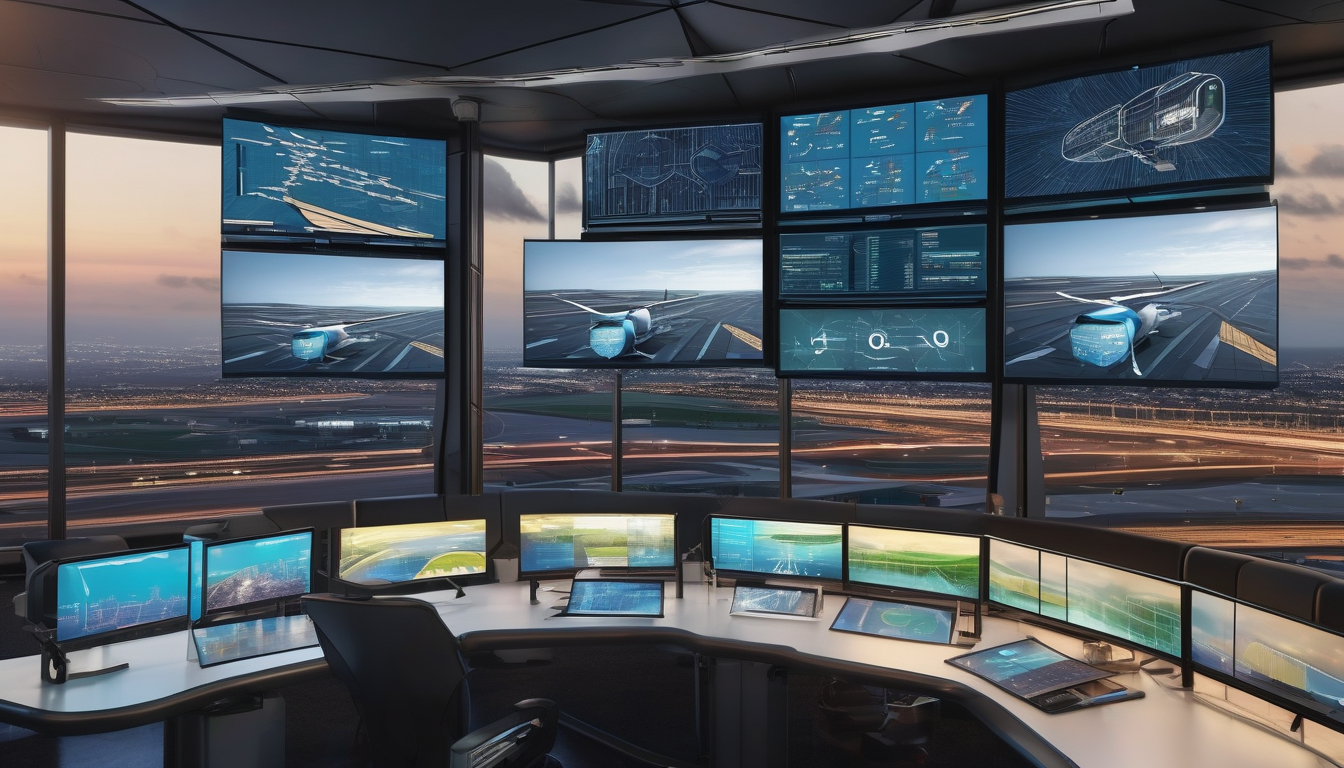Artificial Intelligence (AI) is not just a buzzword; it’s a game-changer in the aviation industry. Imagine a world where flying is not only safer but also more efficient and enjoyable. With AI stepping into the cockpit, this dream is becoming a reality. From predicting mechanical failures before they happen to personalizing passenger experiences, AI is revolutionizing the skies in ways we never thought possible. It’s like having a super-intelligent co-pilot who never sleeps!
At the heart of aviation safety, AI is making waves. By utilizing advanced algorithms, it’s able to predict and mitigate risks that could jeopardize flights. Think of it as a safety net that catches potential problems before they escalate. For instance, AI systems analyze historical data and real-time inputs to enhance decision-making processes during critical situations. This means that pilots and ground control can react faster and more effectively, ensuring that safety is always the top priority.
But that’s not all! AI is also streamlining flight operations. Airlines are now harnessing the power of AI to sift through vast amounts of data, which helps in optimizing flight routes, reducing fuel consumption, and improving overall operational efficiency. This is a win-win situation: airlines save money, and passengers enjoy fewer delays. It’s like having a GPS that not only tells you the best route but also predicts traffic jams before you hit the road!
One of the most exciting applications of AI is in predictive maintenance. This technology allows airlines to foresee mechanical issues before they arise. Imagine being able to fix a problem before it even becomes one! By analyzing data from various sensors, AI helps in timely interventions, enhancing aircraft reliability and reducing downtime. This means planes stay in the air longer, and passengers reach their destinations without unexpected hiccups.
Advanced data analysis techniques are another feather in AI’s cap. Airlines can now monitor aircraft performance in real-time, identifying patterns and anomalies that could indicate potential issues. This not only ensures optimal functioning but also enhances safety throughout the aircraft’s lifecycle. It’s like having a health monitor for your plane that keeps track of its well-being!
Implementing AI-driven predictive maintenance strategies can significantly lower operational costs. By minimizing unexpected repairs and extending the lifespan of aircraft components, airlines can save a fortune. This proactive management approach is crucial in an industry where every dollar counts.
Let’s not forget about the passengers! AI is transforming the travel experience by personalizing services, improving check-in processes, and providing real-time updates. Imagine walking into an airport where your preferences are already known, and your journey is tailored just for you. This level of personalization leads to greater customer satisfaction and loyalty, making flying a more enjoyable experience.
Furthermore, AI is revolutionizing air traffic management. By optimizing flight paths and reducing congestion, it enhances communication between pilots and air traffic controllers, ensuring safer and more efficient airspace utilization. It’s like having a conductor for an orchestra, ensuring that every note is played at the right time without any chaos!
Real-time data integration is essential for better communication and coordination among various air traffic control systems. This ensures that all stakeholders have access to accurate and timely information, which is vital for smooth operations.
Lastly, the automation of air traffic control processes through AI technologies improves efficiency and safety. With quicker response times and more effective management of air traffic flow, AI is paving the way for a future where flying is not only safer but also more efficient.

AI-Driven Safety Enhancements
Artificial intelligence is playing a crucial role in enhancing safety measures within the aviation industry. Imagine a world where pilots and air traffic controllers can predict and mitigate potential risks before they even occur. With the help of advanced algorithms, AI analyzes vast amounts of data from various sources, allowing for better decision-making processes during critical situations.
One of the most significant advancements AI brings to aviation safety is its ability to process data in real-time. This means that as conditions change—be it weather fluctuations, technical issues, or unexpected air traffic—AI systems can quickly evaluate the situation and suggest optimal responses. This proactive approach is akin to having a personal safety net that tightens just before a fall.
Furthermore, AI can identify patterns and anomalies that human operators might overlook. For instance, by continuously monitoring flight data, AI can spot trends that indicate potential mechanical failures. This is where predictive analytics comes into play, allowing airlines to intervene before a small issue snowballs into a major problem. The result? Fewer accidents and a significant boost in overall safety.
To illustrate this point, consider the following table that highlights the key benefits of AI-driven safety enhancements:
| Benefit | Description |
|---|---|
| Risk Prediction | AI predicts potential risks by analyzing historical and real-time data. |
| Timely Interventions | Allows for quick decision-making to address emerging safety concerns. |
| Enhanced Monitoring | Continuous surveillance of aircraft systems to detect anomalies. |
In conclusion, the integration of AI in aviation safety protocols not only enhances the security of flights but also instills greater confidence among passengers. With AI acting as a vigilant guardian, the aviation industry is on a path to achieving unprecedented safety standards.

Optimizing Flight Operations
Artificial intelligence is a game-changer in the aviation sector, particularly when it comes to . Imagine a world where airlines can analyze mountains of data in real-time, making split-second decisions that enhance efficiency and cut costs. Sounds like science fiction, right? But it’s happening now! AI technologies are enabling airlines to fine-tune their flight routes, ensuring that every journey is as smooth and fuel-efficient as possible.
One of the most exciting features of AI in aviation is its ability to reduce fuel consumption. By analyzing factors such as weather patterns, air traffic, and aircraft performance, AI can suggest the most efficient flight paths. This not only saves money but also significantly lowers the carbon footprint of airlines. In fact, studies show that optimized flight routes can lead to a reduction in fuel usage by up to 10%!
Moreover, AI helps in minimizing delays, which is a win-win for both airlines and passengers. When airlines can predict potential disruptions—like bad weather or air traffic congestion—they can proactively adjust their schedules. This means fewer late departures and arrivals, resulting in happier travelers. To illustrate this, consider the following table that highlights the impact of AI on flight delays:
| Year | Average Flight Delays (minutes) | Impact of AI (Estimated Reduction) |
|---|---|---|
| 2020 | 15 | 3 |
| 2021 | 12 | 4 |
| 2022 | 10 | 5 |
This table clearly shows how AI’s implementation has led to a steady decline in flight delays over the years. As airlines continue to adopt these advanced technologies, we can expect even greater improvements in operational efficiency.
In conclusion, the integration of AI in optimizing flight operations is not just about making things faster; it’s about creating a safer and more efficient flying experience for everyone involved. The future of aviation is bright, and AI is at the forefront of this transformation!
Predictive Maintenance
In the fast-paced world of aviation, is emerging as a game-changer. Imagine a scenario where airlines can foresee mechanical issues before they become a headache. This is not just wishful thinking; it’s a reality made possible by artificial intelligence. By leveraging advanced algorithms and real-time data analysis, airlines can monitor their fleet’s health continuously, ensuring that every aircraft remains in peak condition.
So, how does this all work? Well, AI analyzes a treasure trove of data collected from various sensors installed on aircraft. These sensors track everything from engine performance to hydraulic systems. When the AI spots a pattern or anomaly—like increased vibrations in an engine—it can alert maintenance crews before a minor issue escalates into a major problem. This proactive approach not only enhances aircraft reliability but also significantly reduces downtime, allowing airlines to keep their schedules running smoothly.
Furthermore, the benefits of predictive maintenance extend beyond just avoiding costly repairs. Consider the following advantages:
- Cost Efficiency: By addressing potential issues early, airlines can save on unexpected repair costs.
- Increased Safety: Ensuring that aircraft are in optimal condition reduces the risk of in-flight failures.
- Extended Lifespan: Regular monitoring and timely interventions can prolong the life of critical components.
As airlines continue to embrace this technology, the landscape of aviation maintenance is transforming. With predictive maintenance, the focus shifts from reactive measures to a more strategic, data-driven approach. This not only enhances safety but also contributes to a more efficient and cost-effective operation. In an industry where every second counts, being able to predict and preemptively address maintenance needs is like having a crystal ball for your aircraft.
Data Analysis Techniques
In the rapidly evolving aviation industry, are becoming the backbone of operational efficiency and safety. Airlines are leveraging sophisticated algorithms to sift through massive datasets, extracting valuable insights that help in real-time decision-making. Imagine having a highly skilled detective on your team, tirelessly analyzing every clue to ensure that everything runs smoothly—that’s what AI does for airlines.
One of the most significant advantages of these techniques is the ability to monitor aircraft performance continuously. By employing machine learning models, airlines can identify patterns that may indicate potential issues before they escalate into serious problems. For instance, if an aircraft’s engine temperature consistently rises above a certain threshold, the system flags it for further inspection. This proactive approach not only enhances safety but also extends the lifespan of aircraft components.
Moreover, advanced data analysis techniques allow airlines to conduct predictive analytics. This involves using historical data to forecast future events, such as maintenance needs or flight delays. By anticipating these occurrences, airlines can schedule maintenance during off-peak hours, minimizing disruption and optimizing resources. Here’s how it works:
| Data Type | Analysis Technique | Benefit |
|---|---|---|
| Flight Data | Predictive Analytics | Reduced Delays |
| Maintenance Logs | Machine Learning | Increased Reliability |
| Customer Feedback | Sentiment Analysis | Enhanced Services |
Furthermore, these data analysis techniques provide airlines with the ability to conduct sentiment analysis on passenger feedback. By understanding customer preferences and pain points, airlines can tailor their services to enhance the overall travel experience. Whether it’s improving in-flight entertainment or streamlining check-in processes, the insights gained from data analysis are invaluable.
In conclusion, the integration of advanced data analysis techniques in aviation not only boosts operational efficiency but also significantly enhances safety and passenger satisfaction. As the industry continues to embrace these innovations, the sky truly is the limit.
Cost Reduction Strategies
In the fast-paced world of aviation, cost reduction is more than just a goal; it’s a necessity. Airlines are constantly seeking ways to cut expenses without compromising safety or service quality. One of the most effective strategies lies in the implementation of AI-driven predictive maintenance. By utilizing advanced algorithms and data analysis, airlines can foresee potential mechanical failures before they occur. This proactive approach not only minimizes the risk of in-flight incidents but also significantly reduces the costs associated with unexpected repairs.
Imagine a scenario where an aircraft is grounded due to an unforeseen issue. The financial implications can be staggering, from lost revenue to costly repairs. However, with predictive maintenance, airlines can schedule maintenance during off-peak times, ensuring that flights remain on schedule and operational costs are kept in check. This strategy also extends the lifespan of aircraft components, allowing airlines to maximize their investments.
Moreover, AI technologies enable airlines to analyze data across various operational aspects, leading to informed decision-making. For instance, by examining fuel consumption patterns, airlines can identify inefficiencies and adjust flight routes or schedules accordingly. This not only contributes to fuel savings but also enhances overall operational efficiency.
To illustrate the impact of these strategies, consider the following table that highlights the potential savings from AI-driven initiatives:
| AI Initiative | Potential Savings |
|---|---|
| Predictive Maintenance | $1 million annually |
| Fuel Efficiency Optimization | $500,000 annually |
| Operational Efficiency Improvements | $750,000 annually |
In summary, the integration of AI in aviation not only enhances safety but also plays a pivotal role in reducing operational costs. By embracing these innovative technologies, airlines can ensure a sustainable future while maintaining high standards of safety and customer satisfaction.
Enhanced Passenger Experience
Artificial Intelligence is not just about making flights safer and more efficient; it’s also about transforming the passenger experience into something truly remarkable. Imagine walking into an airport where every interaction is tailored just for you! With AI, this is becoming a reality. From personalized services to real-time updates, the travel experience is evolving at lightning speed.
One of the most exciting advancements is the personalization of services. Airlines are now using AI algorithms to analyze your travel history and preferences. This means that when you check in, the system already knows your favorite meal or preferred seat. No more guessing games or generic options! Instead, you’re greeted with choices that feel curated just for you.
Additionally, AI is streamlining the check-in process. Gone are the days of long lines and tedious paperwork. With AI-powered kiosks and mobile apps, passengers can check in effortlessly, reducing wait times significantly. This is not just about convenience; it’s about enhancing the overall travel experience. Who wouldn’t want to breeze through the airport like a VIP?
Furthermore, real-time updates are a game changer. With AI, airlines can provide instant notifications about flight changes or gate information directly to your smartphone. This means less time worrying about missed connections and more time enjoying your trip. Imagine receiving a notification that your flight is delayed, but you also get suggestions for nearby cafes or shops to explore while you wait!
In summary, AI is revolutionizing the passenger experience by:
- Personalizing services based on individual preferences
- Streamlining check-in processes for quicker access
- Providing real-time updates to keep passengers informed
As we look to the future, it’s clear that AI will continue to enhance our journeys, making air travel not just a necessity but a pleasure.

AI in Air Traffic Management
Artificial intelligence is revolutionizing air traffic management, making our skies safer and more efficient than ever before. Imagine a world where flights are perfectly synchronized, reducing delays and enhancing passenger experiences. With AI, this is becoming a reality! By leveraging advanced algorithms, air traffic control systems can analyze vast amounts of data in real-time, allowing for quicker and more informed decision-making.
One of the standout features of AI in air traffic management is its ability to optimize flight paths. This means that instead of flying in a straight line, aircraft can take the most efficient routes, saving time and fuel. As a result, airlines can offer more reliable schedules, leading to happier travelers. But how does it work? AI systems utilize real-time data integration to gather information from various sources, including weather patterns, air traffic, and even aircraft performance. This comprehensive data analysis helps controllers make better decisions on the fly.
Moreover, the automation of air traffic control processes is a game-changer. By implementing AI technologies, air traffic controllers can manage air traffic flow more effectively. This not only improves response times but also enhances overall safety. For example, AI can predict potential congestion points and suggest alternative routes before issues arise, acting like a traffic cop in the sky!
To sum it up, AI is transforming air traffic management in several key ways:
- Optimized Flight Paths: Reducing delays and fuel consumption.
- Real-Time Data Integration: Ensuring accurate and timely information for better decision-making.
- Automation of Processes: Enhancing efficiency and safety in air traffic control.
As we embrace these technological advancements, the future of aviation looks bright. AI not only streamlines operations but also enhances communication between pilots and air traffic controllers, paving the way for a safer and more efficient airspace. So, the next time you board a plane, remember that AI is working tirelessly behind the scenes to ensure your journey is as smooth as possible!
Real-Time Data Integration
In the fast-paced world of aviation, is nothing short of a game changer. Imagine a bustling airport where every second counts; the ability to access and share information instantly can make all the difference. With AI at the helm, air traffic control systems can now communicate seamlessly, allowing for enhanced coordination among various stakeholders, including pilots, ground crews, and air traffic controllers.
This integration is not just about sharing data; it’s about creating a dynamic ecosystem where information flows freely and efficiently. For instance, when a flight experiences a delay, real-time data can alert ground crews to adjust staffing and resources accordingly. This proactive approach minimizes passenger frustration and ensures that operations run smoothly.
Furthermore, the integration of real-time data helps in enhancing safety protocols. By continuously monitoring weather conditions, flight paths, and aircraft performance, AI systems can provide timely updates and recommendations. This allows pilots and air traffic controllers to make informed decisions quickly, reducing the risk of accidents and improving overall safety in the skies.
To illustrate the impact of real-time data integration, consider the following table:
| Aspect | Before Real-Time Integration | After Real-Time Integration |
|---|---|---|
| Communication Speed | Delayed updates, potential miscommunication | Instantaneous updates, clear communication |
| Operational Efficiency | Frequent delays, resource mismanagement | Streamlined operations, optimal resource allocation |
| Safety Measures | Reactive measures, slower response times | Proactive measures, enhanced decision-making |
In conclusion, the integration of real-time data is revolutionizing the aviation industry. It not only enhances operational efficiency but also significantly boosts safety measures. As we continue to embrace these technological advancements, the future of air travel looks brighter than ever.
Automation of Air Traffic Control
Imagine a world where air traffic control is as seamless as a well-choreographed dance. through artificial intelligence (AI) is making this vision a reality. By leveraging advanced algorithms and machine learning, AI enhances the efficiency and safety of managing air traffic, ensuring that planes navigate the skies with precision and minimal delays.
One of the key benefits of automating air traffic control is the reduction of human error. Traditional methods rely heavily on human judgment, which can be susceptible to fatigue and lapses in concentration. AI, on the other hand, processes vast amounts of data in real-time, allowing for quicker decision-making and improved situational awareness. This means that air traffic controllers can focus on strategic oversight while AI handles routine tasks, leading to a safer flying environment.
Furthermore, the integration of AI in air traffic management systems enables dynamic flight path optimization. By analyzing weather patterns, air traffic density, and other variables, AI can suggest the most efficient routes for aircraft. This not only helps in reducing fuel consumption but also minimizes congestion in busy airspaces. For instance, AI can adjust flight paths on-the-fly, allowing planes to avoid turbulence or adverse weather conditions, enhancing passenger comfort and safety.
Another significant aspect of automation is the real-time data integration capability. With AI systems, all stakeholders, including pilots, air traffic controllers, and ground services, have access to the same up-to-date information. This level of transparency fosters better communication and coordination, which is crucial for maintaining safety and efficiency in increasingly crowded skies.
In conclusion, the automation of air traffic control represents a transformative leap forward for the aviation industry. By harnessing the power of AI, we are not only improving operational efficiency but also paving the way for a future where air travel is safer, faster, and more reliable than ever before.
Frequently Asked Questions
- How does AI enhance safety in aviation?
AI enhances safety by utilizing advanced algorithms to predict potential risks, allowing airlines to make informed decisions during critical situations. This proactive approach helps in mitigating risks before they escalate.
- What role does AI play in optimizing flight operations?
AI analyzes vast amounts of data to optimize flight routes, reduce fuel consumption, and improve overall operational efficiency. This not only minimizes delays but also cuts costs for airlines.
- What is predictive maintenance in aviation?
Predictive maintenance uses AI to anticipate mechanical issues before they occur, ensuring timely interventions. This reduces downtime and enhances the reliability of aircraft, making air travel safer.
- How does AI improve the passenger experience?
AI personalizes services, streamlines check-in processes, and provides real-time updates, making travel smoother and more enjoyable for passengers. This leads to higher customer satisfaction and loyalty.
- What advancements are being made in air traffic management with AI?
AI is revolutionizing air traffic management by optimizing flight paths, reducing congestion, and enhancing communication between pilots and air traffic controllers, ensuring safer and more efficient airspace utilization.
- How does real-time data integration benefit air traffic control?
Real-time data integration allows for better communication and coordination among air traffic control systems, ensuring that all stakeholders have access to accurate and timely information, which is crucial for safety.



